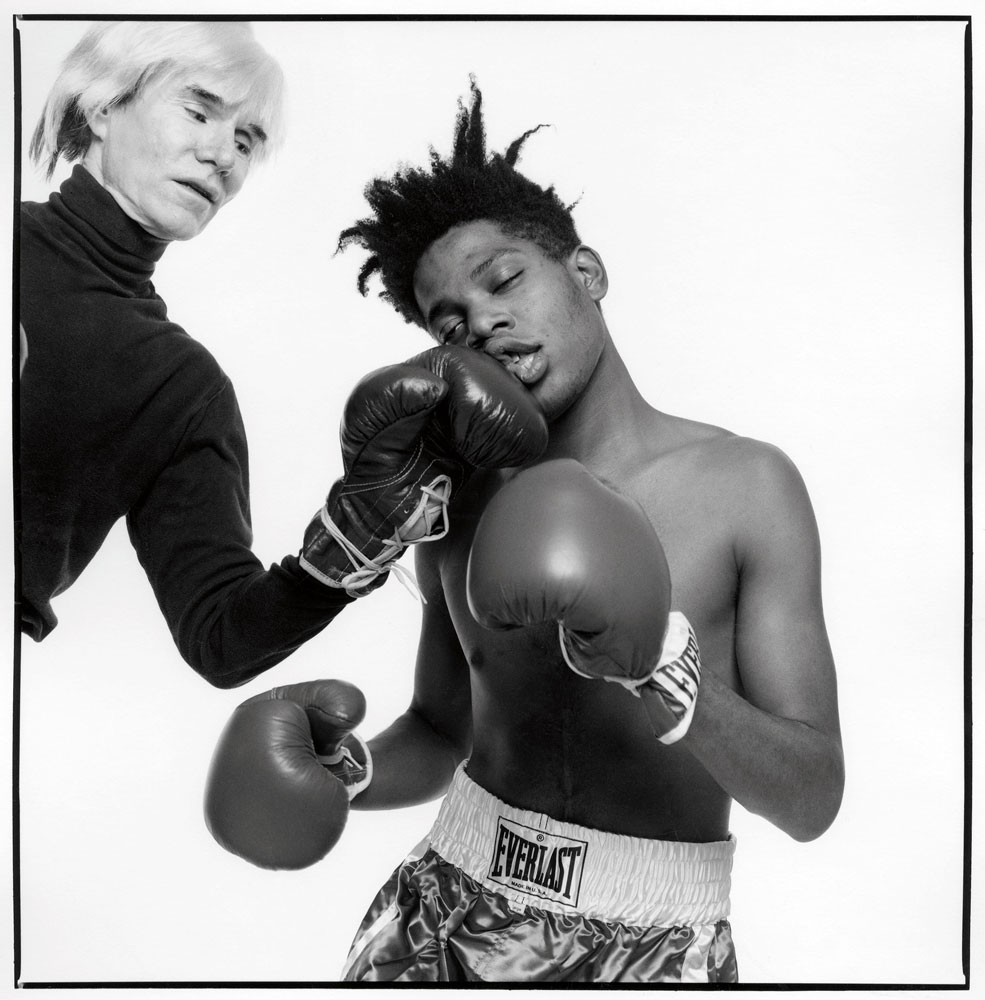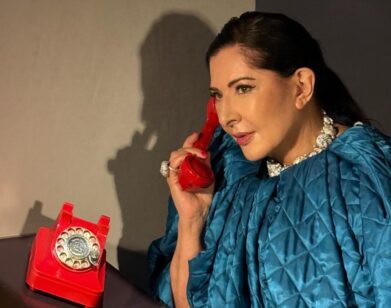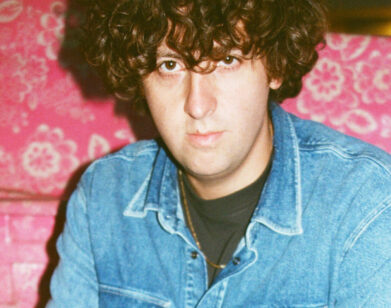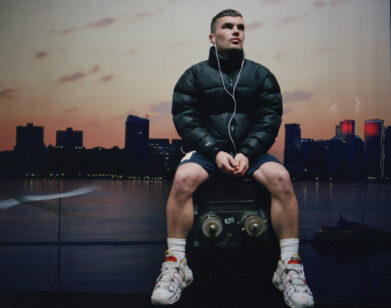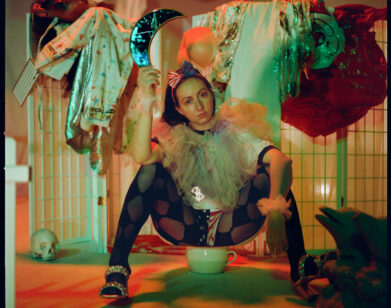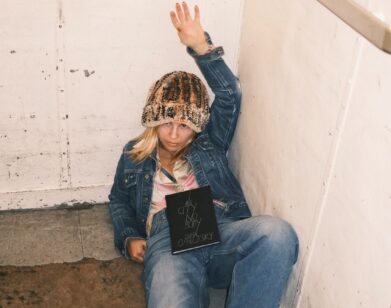Inside the World of Michael Halsband
In perhaps one of the most iconic photos of Andy Warhol the artist stands next to Jean-Michel Basquiat. Both cross their arms over their chests, donning Everlast boxing gloves and shorts. Basquiat is shirtless; Warhol wears his trademark black turtleneck. American photographer Michael Halsband took this photo in 1985 to promote the artists’ collaborative art exhibition, and subsequently became a frequent Interview contributor while Warhol was still alive. At the time, Halsband’s work—which includes a vast array of portraits of 20th century cultural icons such as James Brown, David Byrne, Johnny Depp, and Iggy Pop—was also featured in ARTnews, and has since been featured in publications like GQ and Vogue, among others. Last night marked the opening reception for his latest exhibition, “Halsband Portraits,” at the National Arts Club in New York.
In the exhibition, more than 50 images are on display and collectively provide a bird’s-eye view of the photographer’s career. All of this work is a self-portrait,” Halsband says of the exhibit. “It’s my choices of things that were cool to me and that I felt so compelled about that I wanted to share them with everybody.”
Currently, Halsband is working with actor and writer Calvin Levels to create a show that explores the dynamic relationship between Warhol and Basquiat. Prior to the exhibition opening, the two New Yorkers connected over the phone.
CALVIN LEVELS: Alright, Mr. Halsband. How are you feeling about the show?
MICHAEL HALSBAND: It’s like a blur. At this point, the moments are just speeding up and everything is falling into place. It’s like watching my life pass before my eyes, really.
LEVELS: How did it come together?
HALSBAND: I started in the early fall, when summer ended, and realized how much I needed to organize it. Really, “organize” is the key word because it was a matter of figuring out what I had, how I was going to present it, and how to edit it down to the strongest, most powerful, with no filler. It’s looking at the work and getting distracted by all the memories or the thoughts that it triggers and trying to stay focused, to have some distance.
LEVELS: I want to ask you about a few of the photos—the Klaus Nomi and the Basquiat [and] Warhol photo with the boxing gloves. I know Klaus Nomi and Jean-Michel Basquiat had been admiring you for a number of years.
HALSBAND: I don’t know if many people really know about Klaus Nomi. I didn’t know much about Klaus except that I saw him in the street and he was such a fully self-realized character. I just thought this guy was totally compelling. It was probably ’78 or so when I finally got the courage to ask Joey Arias, who was working closely with Klaus, if I could make some portraits of Klaus in his costume and make up. I didn’t want to offend Joey, so I said, “Hey, Joey, why don’t we do a portrait of you and Klaus?” That was my way of getting to Klaus in a funny way. In the end, Joey and Klaus were two completely self-realized forces that it turned out to be a spectacular collaboration between the three of us.
LEVELS: So then how did you get to Jean-Michel and Andy?
HALSBAND: Cut to five years later and I did this group portrait for Area, the club. Area was changing their themes every three months—I had done one theme for them and then they wanted me to do a portrait with all these artists that they had invited to contribute to this theme called “art.” They had a dinner party at Mr. Chow and Eric Goode asked me if I could do the group portrait of them. Jean-Michel was one of the artists in the group, and Schnabel—
LEVELS: He probably got like 20 artists, right?
HALSBAND: Yeah, Francesco Clemente, Robert Mapplethorpe, and Keith Harring. Warhol was there and John Chamberlain and Michael Heizer. The list just goes on. I don’t know how many people are in the picture—40 or so.
So anyway… I approached Jean, but he wasn’t friendly and I just walked away and figured I wasn’t going to get anywhere. A few months later, Andy invited me to a dinner in the back room of a restaurant. The only seat left at the table was next to Jean, and when I sat down, Jean turned to me and said, “I’ve been an admirer of your work for the past five years,” and I thought, “What a bunch of bullshit.” [laughs] Then he said, “The first work of yours, I saw!” I thought, “Wow. That was exactly five years ago. He’s being very real about it, and he knows what he’s talking about!” So we started talking, and he asked me if I wanted to go to the bathroom with him. We ended up having this meeting in the bathroom where he explained that he wanted to do this poster with Andy for the upcoming exhibition of work they had been collaborating on. I said, “Yeah, I’d love to!” and then we walked out of the bathroom, and he says to Andy, “Michael’s going to do the portrait of us. A boxing poster.” Then Andy said, “I thought we already asked Robert Mapplethorpe to do it?” And Jean said, “No, Michael’s going to do it.”
LEVELS: A year and a half ago, Michael Hermann from the Warhol Foundation was looking at that particular photo session. I had just sent him an invitation to see an excerpt from the play and he emailed me back and said, “Would you like to get in touch with the guy who took that iconic photo?” I said, “I’d love to,” so you came to see the piece and we’ve been inseparable since. [laughs] I said, “Wow this guy is so insightful and perceptive on every level. I would love to work together, particularly on the play.” That’s how we met.
HALSBAND: I don’t have this interaction with everybody, Calvin. It’s not just, “Oh Michael is so insightful.”
LEVELS: But you are! At The Actors Studio, we have people commenting on the work—they have been in this life and make comments about the piece and what they see in the scene. Then I’ll go back to your place with you and you really dissect it. You don’t come from that discipline and it’s amazing, to me, that you have that insight and can articulate it so well.
HALSBAND: Maybe it’s just me as a portrait photographer. We spend a lot of time observing human behavior and digging deeply. It’s all this observation and then figuring out what part of it you’re going to utilize and incorporate in the construction of whatever you’re building—a photograph or performance. I think we share that interest and we’re not one-dimensional in a sense that we’re concerned with only that. Some people get very attached to one aspect of something, and all of a sudden, there’s no human element in it. There’s no breathing or being a part of it yourself.
LEVELS: You told me that your mom bought you a camera. What were the first photos that you started taking? You had a thing with rock-‘n’-roll, you did The Rolling Stones tour, but where did you start?
HALSBAND: I started at 10 years old, wanting to play the guitar. I got into music very early and couldn’t get enough of it, and I couldn’t play very well either. [laughs] I was really struggling. I was so frustrated, but I passionately loved music. Then a schoolmate opened a door in a hallway one day, and said, “Hey, come in here!” I walk in, and it’s this dark room and there was this amber light. I said, “What’s this?” and he said, “It’s a photo dark room.” He turned the light out, made an exposure, and put the paper he had exposed into the first chemical bath. I saw this image come up and thought, “This is what I want to do. This is it.”
I connected with it right there. I thought this was magic and I wanted to do it. I went home and asked my parents for a camera. I said, “I discovered photography in school, and I really wanted a camera to take pictures and develop them,” and they said, “You keep coming up with all these hobbies and interests! We got you a guitar and now you want a camera. If you still are interested in photography in a year, we’ll get you a camera on your birthday.”
I took a shoebox of family negatives and spent a year developing those because I couldn’t stop wanting to print. I actually didn’t really miss the camera so much. When the year came up and the deal was being honored, I got the camera, and it felt like such a powerful tool. I thought so much about wanting it but I didn’t really think about what I was going to do when I got it. It was a very overwhelming feeling trying to figure out what it was, what I was going to do with this camera, and what I was going to make pictures of.
LEVELS: Do you remember your first photo? I was wondering about the earlier rock shots, they seem a little more about the show…
HALSBAND: At 11 years old, I went to the Fillmore for the first time—
LEVELS: How did you get in at 11?
HALSBAND: They didn’t have an age limit in 1967! So I got in and then kept going back every weekend and bumming tickets. The first one, I was on a date with a girl. I took her to see Joe Cocker and after that, I was obsessed about going to shows.
LEVELS: Do you still have some of those photos?
HALSBAND: Yeah, and I have all the ticket stubs, all the programs—this is when they still had programs for all the shows. It’s like this magazine.
LEVELS: I know you also love to surf and you love the surf culture.
HALSBAND: Surfing was another thing I fell in love with. I had been surfing on and off when I could, but I grew up in New York City; I couldn’t do it very much. When I finally reached an age where I could drive and get out on my own, I started to get very seriously into surfing.
LEVELS: You did a book about surfing.
HALSBAND: That book is just like evidence of a journey. It reflects what I went through. We started in September ’99 and it was finished and printed, and we had the party for it in 2005. So it was a six-year odyssey of sorts, but it was really a solid five-year project. In every sense, it was revelatory. It shifted my whole life in the same way that, say, touring with The Rolling Stones did. [laughs] It just was a slower process, because The Stones tour was four months long with a little bit of rehearsal on the front end and a lot of editing and working with Mick on the back end. I learned a lot from it, and I got a lot out of it, and I brought a lot of what I knew from my earlier years to it.
LEVELS: Speaking of your earlier years…[laughs]
HALSBAND: Let’s go back again. [laughs]
LEVELS: We’re talking for Interview. Do you remember your first shot that you took of Andy?
HALSBAND: [laughs] Calvin, I love you, man. The way I met Andy was funny. I used to see Andy at the Fillmore East when I was really young. He would be down in the lobby, he was way into going to every music venue in New York and hanging around. Back then, you have to remember, there were no scenes. There was nothing more than bars. It was nothing like what it is today. There were bars to hang out at and there was music. The Fillmore was the first major music scene.
LEVELS: What’s that bar on St. Marks place that Andy used to hang out at?
HALSBAND: The Bitter End?
LEVELS: No, no. It was an old Polish hall, and the Velvet Underground played there, they had the live show, and there was shooting up on stage, and Andy was up in the booth? That probably was defunct by then…
HALSBAND: Yeah, and they probably wouldn’t have let an 11-year-old in… [laughs]
LEVELS: [laughs] Not where they were shooting up.
HALSBAND: I don’t know—I went to a lot of places where I saw that going down, but luckily I was spared…So, ARTnews had asked me to work on a story on eight artists in their studios, portraits of artists. We got a list, and on the list was Andy Warhol, but everyone was too chicken to call him. So they said, “Michael, we’re going to put him on your list to call,” and I was like, “Oh man, how do I start? How do I begin? How do I approach Andy Warhol?” [laughs] But crazily enough, four days later, I was walking down Madison Avenue with my girlfriend. It was super early and the stores hadn’t opened yet. There was nobody on the street. We were walking uptown, and all of a sudden Andy Warhol walked past us. I said to my girlfriend, “I need to run after him about this portrait,” and I ran back a block, out of breath and stalked him. He was super sweet. He said, “Oh yeah, that’d be great, just call the Factory and tell them the story and I’ll tell them I’m going to do it. I’ll tell whoever it’s alright.”
LEVELS: He used to do that a lot with people, except this was legitimate. Sometimes he would blow people off, you know?
HALSBAND: I had that feeling. I was like, “Is this really going to happen?” and he’s like, “Yeah, yeah, yeah. I’ll make sure that they know that I spoke to you.” I had this feeling I was going to call and get nowhere. How was I going to prove this? But then I went and made that picture of him in the Factory on 17th Street. When we were up there he took me to meet the people who worked on Interview. He said, “You should get Michael to do some portraits for the magazine.” I could tell by the vibe that they were so not into being told what to do. [laughs] But in the end, they called and gave me portraits to do.
LEVELS: So the first photo of Andy that you took—that’s the one with him and the tie on, with the suit jacket?
HALSBAND: That’s the second picture I took of him, which was on the cover of ARTnews. By then, things were a lot more comfortable and I just called him directly and said, “ARTnews wants to do a cover with you.” Andy came over to my studio alone and we took the pictures. That was probably my first big cover.
LEVELS: In acting, there are fundamentals that ground you, that enrich your work, that ignite the imagination. Are there fundamentals in photography that you need to always go back to that will spark the imagination or that ground you, or that are really essential for enriching a piece of work?
HALSBAND: I always stress this when I teach this portraiture class at the School of Visual Arts: Every time you put the camera in your hands or you step up to the camera, you start from the beginning, you don’t jump into the middle. So, I build everything from the ground up, and I’m always thinking, “Where do I want to go? What do I envision as the end and how do I get there?” Everything is informed by that end result image in my mind. If something better comes up on the way that changes the whole course of it, then so be it. It’s trying to be intuitive and respond to things from a place beyond my own superficial consciousness.
LEVELS: So one last question: I know this might be unfair, but which rock tour was the most rewarding for you and why?
HALSBAND: Touring with the Rolling Stones was a dream come true from age 12. All of a sudden I was doing it and I can’t believe I got that opportunity, but I also know that I worked really hard to educate myself for that moment. I don’t know why I was lucky enough but I wanted it so bad—maybe that was just enough.
AC/DC was another one of my most favorite bands, and again, I wanted it really badly. I wrote to their manager and kept writing to him, and three or four publicists recommended me at the same time, and we’ve been friends ever since. I don’t photograph them anymore, but I have something better, which is a friendship. We’re best friends, so it’s great.
“HALSBAND PORTRAITS” IS ON VIEW AT THE NATIONAL ARTS CLUB IN NEW YORK THROUGH APRIL 25.

